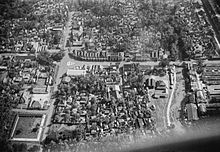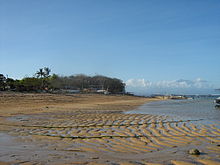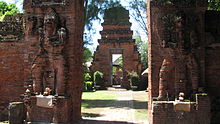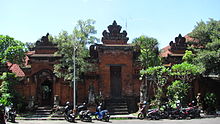Denpasar (Indonesian: Kota Denpasar, Indonesian pronunciation: [denˈpasar], Balinese alphabet: ᬤᬾᬦ᭄ᬧᬲᬃ) is the capital of Bali. Situated on the Bali island, it is known worldwide as a major tourist destination, and is the main gateway to Bali. The city is also a hub for other cities in the Lesser Sunda Islands.
With the rapid growth of the tourism industry in Bali, Denpasar has encouraged and promoted business activities and ventures, contributing to it having the highest growth rate in Bali Province. The population of Denpasar was 834,881 in 2012, up from 788,445 at the 2010 Census. The surrounding metropolitan area has roughly 2 million residents. The municipality's area extent, population, and density are similar to San Francisco.
The name Denpasar - from the Balinese words "den", meaning north, and "pasar", meaning market - indicates the city's origins as a market-town, on the site of what is now Kumbasari Market (formerly "Peken Payuk"), in the northern part of the modern city.
History
Colonial era
Denpasar was the capital of the Kingdom of Badung. The royal palace was looted and razed during the Dutch intervention in 1906. A statue in Taman Puputan (Denpasar's central square) commemorates the 1906 Puputan, in which as many as a thousand Balinese, including the King and his court, committed mass suicide in front of invading Dutch troops, rather than surrender to them.
Independence era
In 1958 Denpasar became the seat of government for the Province of Bali. It remained the administrative centre of both Badung Regency and the City of Denpasar.
Both Denpasar and Badung Regency have experienced rapid physical, economic, social and cultural growth. Denpasar has become not only the seat of government, but also the centre of commerce, education, industry, and tourism.
Average population growth of 4.05% per annum, accompanied by rapid development, led to a variety of urban problems. It was resolved that meeting the needs and demands of the burgeoning urban community would best be addressed by giving Denpasar administrative independence from Badung Regency. Agreement was reached to raise the status of Denpasar to that of an autonomous City, and on 15 January 1992, Act No. 1 of 1992 officially established the City of Denpasar. It was inaugurated by the Minister of Home Affairs on 27 February 1992.
On 16 November 2009, in a further administrative realignment, Regulation Number 67 shifted the capital of Badung Regency from Denpasar to Mangupura.
Geography
Denpasar is located at a height of 0-75 mdpl. While the total area of 127.78 km² or 2.18% of the total area of Bali Province. From the use of land, 2,768 hectares of land are paddy, 10,001 hectares are dry land, while the remaining land area is 9 hectares.
Badung River divides Denpasar, after which the river empties into the Gulf of Benoa.
Climate[edit]
Denpasar, located just south of the equator, has a tropical wet and dry climate (Köppen climate classification Aw), with hot and humid weather. Due to this there is little temperature change throughout the year. Unlike many cities outside Indonesia with this climate, there is very little seasonal temperature change, with temperatures averaging about 28 degrees Celsius. The year is divided into two seasons: wet and dry. The wet season lasts roughly from November to April, while the dry season lasts from May to October. The temperatures are not extreme, but the heat, combined with the oppressive humidity and copious precipitation, makes the climate very uncomfortable at times.
| [hide]Climate data for Denpasar | |||||||||||||
|---|---|---|---|---|---|---|---|---|---|---|---|---|---|
| Month | Jan | Feb | Mar | Apr | May | Jun | Jul | Aug | Sep | Oct | Nov | Dec | Year |
| Average high °C (°F) | 33.0 (91.4) | 33.4 (92.1) | 33.6 (92.5) | 34.4 (93.9) | 33.1 (91.6) | 31.4 (88.5) | 30.4 (86.7) | 29.6 (85.3) | 31.4 (88.5) | 33.6 (92.5) | 32.7 (90.9) | 33.0 (91.4) | 32.47 (90.44) |
| Average low °C (°F) | 24.1 (75.4) | 24.2 (75.6) | 24.0 (75.2) | 24.8 (76.6) | 24.1 (75.4) | 23.5 (74.3) | 23.0 (73.4) | 22.5 (72.5) | 22.9 (73.2) | 23.7 (74.7) | 23.5 (74.3) | 23.5 (74.3) | 23.65 (74.58) |
| Average precipitation mm (inches) | 345 (13.58) | 274 (10.79) | 234 (9.21) | 88 (3.46) | 93 (3.66) | 53 (2.09) | 55 (2.17) | 25 (0.98) | 47 (1.85) | 63 (2.48) | 179 (7.05) | 276 (10.87) | 1,732 (68.19) |
| Average rainy days | 27 | 22 | 20 | 9 | 8 | 6 | 4 | 4 | 8 | 12 | 16 | 22 | 158 |
| Source: World Meteorological Organisation[7] | |||||||||||||
Demography
The city's population was counted as 788,445 in 2010, up from 533,252 in the previous decade. The provincial website lists the June 2012 population at 834,881.
Denpasar's population grew about 4% per year in the period from 2000 to 2010, Denpasar grew much faster from 2005 to 2010 than in the previous five years. The lingering effects of the 2002 Bali bombings had a major depressive effect on tourism, jobs, and immigration from other islands. However, if current trends continue, Denpasar is expected to easily surpass a million residents by the next census. There are about 4.57% more men than women in Denpasar.
Approximately 68.4% of the population are Hindus, while Islam is the largest minority religion, followed by Christianity, Buddhism, and Confucianism.
Administration
Administratively, the city government consists of 4 districts, subdivided into 43 sub-districts with 209 villages. Currently the City of Denpasar has developed numerous innovations to improve service to the people, in the residence administration began to fix the system.
Districts
Denpasar is divided into 4 districts (kecamatan), listed below with their 2010 Census populations:
- Denpasar Selatan (South Denpasar) 244,851
- Denpasar Timur (East Denpasar) 138,404
- Denpasar Barat (West Denpasar) 229,435
- Denpasar Utara (North Denpasar) 175,899
Greater Denpasar
Greater Denpasar spills out into the tourist regions, including Kuta and Ubud. The continuous built-up area includes nearly all of Badung Regency (except Petang District), all but one of Gianyar Regency (Payangan District). Indonesia defined Metropolitan Denpasar as Sarbagita an acronym for Denpa"Sar"+"BA"dung+"GI"anyar+"TA"banan, with Presidential Regulation Number 45 Year 2011, despite Tabanan just beginning to succumb to urban sprawl. See also List of metropolitan areas in Indonesia.
| Administrative division | Area (in km²) | Population (2010 Census) | Population density (per km2) |
|---|---|---|---|
| Denpasar Municipality | 123.98 | 788,445 | 6,359.45 |
| Badung Regency | 418.52 | 543,332 | 1,293.37 |
| Gianyar Regency | 368.00 | 470,380 | 1,278.21 |
| Denpasar Metropolitan Area | 910.50 | 1,802,157 | 1,979.30 |
| Tabanan Regency | 839.33 | 420,913 | 501.49 |
| Denpasar Extended Metropolitan Area (Sarbagita) | 1,749.83 | 2,223,070 | 1,270.45 |
Economy
The development of tourism and structural changes in the economy have had a strong impact on Denpasar. Trade, hotels, and restaurants dominate the city's gross regional domestic product.
Also boosting the economy of Denpasar is the production of craft items such as souvenir carvings and sculpture. The craft industry, however, is experiencing stress, due to the impact of global financial crises and competition from other Asian developing countries such as Vietnam,Thailand, India, Malaysia and China. These competitor countries maximize the scale of production by utilizing industrial technology, while at Denpasar the craft industry remains focused on traditional skills and hand-made goods, limiting the quantity of production.
Tourism
Denpasar has various attractions. The white sandy beaches are well-known all over the island. The surfing beach is Serangan Island.Sanur beach has calmer waters and is excellent for sunbathing and kitesurfing.
Ten minutes from the Ngurah Rai International Airport lies the town of Kuta. Kuta is where most of the hotels, restaurants, malls, cafes, marketplaces, and spas that cater to tourists are located. In the Denpasar area, all kinds of Balinese handicrafts are represented in local shops. These include artwork, pottery, textiles, and silver.
Batik cloth is sold all over Denpasar, and batik sarongs and men's shirts are widely available.
Education
Denpasar has several notable universities and institutions. Some of them are
- Udayana University
- Warmadewa University
- University of National Education
- Mahasaraswati University of Denpasar
- Indonesian Institute of the Arts, Denpasar
Transportation
Air
The city is served by Ngurah Rai International Airport, one of the busiest in Indonesia.
Sea
Benoa Harbour is the entrance to the City of Denpasar by sea and is currently managed by PT Pelindo III. The port is located about 10 km from the city center, and has been operating since 1924.
Land
Means of transport in the city of Denpasar, especially for urban transportation is starting to be ineffective and inefficient, until the year 2010 only 30% are still in operation, along with the lack of interest of people to use public transport services, which estimated that only about 3% of the total population.[16] While the growth of private vehicle ownership continues to increase to 11% per year and is not comparable with the construction of new roads. Congestion in the city of Denpasar is unavoidable due to this reason.
Since August 2011, the city has operated a bus rapid transit system called Trans Sarbagita. Two main routes and some feeder lines are operated daily from 5 a.m. until 9 p.m. There is no particular lane for the buses, they run on main streets. In 2012 an average of 2800 passengers per day used the service.
Two major improvements of the road system were accomplished in 2013. In August, the underpass at the Dewa Ruci intersection was opened. It is slightly beyond the bounds of Denpasar but was co-financed by the town because of the expected positive effects on traffic in Denpasar.
Then the four-lane Bali Mandara Toll Road was opened on 1 October, connecting Benoa Harbor, Ngurah Rai Airport and Nusa Dua.
Then the four-lane Bali Mandara Toll Road was opened on 1 October, connecting Benoa Harbor, Ngurah Rai Airport and Nusa Dua.
Sport
Denpasar has hosted numerous international and national sporting events. Denpasar was the venue for 2008 Asian Beach Games in Bali. Denpasar also held 2009 Asian Archery Championships.
In football, Denpasar is home to the football club Perseden Denpasar, which plays in the Liga Nusantara.
Culture and Sights
While arts and culture in the city of Denpasar largely synonymous with art and culture in general, although here there has been a mix of interaction with other cultures along with the arrival of tourists from all walks of life. But traditional values inspired by Hindu religious rituals still strong coloring of this city.
Role of Traditional Bali is still rooted in the city of Denpasar, Bali Adat may include, values, norms and behavior in society in general on kinship systems patrilineal . However, over time some of the customary laws began disputed by the people, especially in matters of gender and inheritance.
Denpasar has verious sights to offer:
- Pura Jagatnatha is the most important Hindu temple of Denpasar. It was built in 1953.
- Puri Pemecutan is the former royal palace of Denpasar, which was destroyed in a fire during the Dutch intervention in Bali (1906). The palace was rebuilt in a comparatively modest style and can be visited.
- Pura Maospahit is a Hindu temple which was built in the 14th century and heavily damaged by an earthquake in 1917 and rebuilt afterwards. The temple houses two impressive statues of Garuda and Batara Bayu, a mystic giant.
- St. Joseph Church is a Roman Catholic church built in a Hindu style.
Museum
The Bali Museum features Balinese art and history. The museum is built in Balinese house style. There are four main buildings inside the museum, with their specialization in each building.









Tidak ada komentar:
Posting Komentar